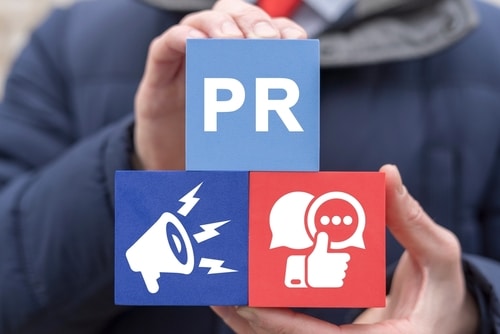The Power of Digital PR: Transforming Your Business in the Digital Age
In today's fast-paced digital landscape, businesses are constantly seeking innovative ways to connect with their target audiences, build brand awareness, and drive growth.
Though traditional Public Relations (PR) via traditional mediums such as newspapers, magazines and trade journals has been around since the late 1800’s and broadcast channels such as television and radio since the start of the last century, with the advent of the internet and the rise of digital media, a new player has emerged.
In this article, we’ll explore what Digital PR is, how it differs from traditional PR, its key elements, and the myriad benefits it offers to businesses in the modern era.
The origin story – Traditional vs Digital PR
Before we can really understand where and how digital PR came about and understand how if fits in the bigger communications picture, lets first go back and frame the back story and origins of PR.
Paperback writers – The Halcyon Days of Print
In its early days, PR was largely centred around print media channels. Newspapers, local papers, newsletters, and lifestyle magazines were the primary platforms for disseminating information and building brand awareness. With little else to entertain and use as a source of information, audiences were captivated by these print publications, and PR professionals relied on them heavily to convey their messages effectively.
Video killed the radio star
In the early 1920s the world witnessed the advent of broadcast media with the introduction first of commercial radio, followed in close succession by television by 1927. The mission and mode of PR remained consistent; to create brand awareness and communicate key messages to target audiences. PR activities included media relations, press release distribution, product launches, and crisis management.
Yesterday’s papers telling yesterday’s news
The late 1990s marked the beginning of a significant transformation in the PR landscape with the emergence of the internet. Hands up anyone old enough reading this who remembers when we all called it the “World Wide Web”?
A key development and turning point arrived with the rise of the search engine giant Google, which absolutely transformed the way information was accessed and shared online. I ask you to find anyone old enough to remember the woeful state and functionality of search engines such as Lycos, Yahoo and Ask Jeeves if they honestly miss those pre Google days. I think you’d be hard stretched to find even the most hard nosed tech head romanticising the alternative!
With the internet came a proliferation of more channels – first websites, then blogs before the social media platforms we all now use and access several times a day as our key medium for information and content sharing.
Today, people spend an average of three hours a day online, making digital the primary and most power platform for brand storytelling and communication.
The evolution of PR
Thanks to the digital age PR has undergone a remarkable evolution in recent years, driven by changing consumer preferences and the proliferation of online channels. While building and nurturing relationships with influential media figures and well-respected publications remains a cornerstone of PR and still helps to build trust and credibility in any brand, business or individual, digital PR differs significantly from its traditional counterpart in various ways. Here’s how:
- It relies on an insight-driven approach – Today’s consumers seek meaningful connections with brands. The direct nature of digital channels means audiences expect a much more personalised content approach and style of communication. To engage them effectively, businesses need to understand their audiences’ needs and preferences.
- It directly supports Search Engine Optimisation (SEO) – Your website serves as a central content hub for your brand. Providing valuable information on your website not only attracts visitors but also encourages journalists to link to your site. High-quality backlinks from authoritative websites are a crucial factor in Google’s ranking algorithm, contributing to higher search engine visibility.
- It provides opportunities to share multidimensional content that appeals to a diverse audience mix – Digital PR offers the flexibility to repurpose one story into multiple content formats to appeal to different audience segments. So whereas your average Baby Boomer generally prefers written long form articles, interviews and reviews, a Gen Z’er prefers short sharp entertaining videos. Recognising that different target audiences consume content in various ways on different online platforms, a successful digital PR campaign may include listicles, how-to guides, whitepapers, social media posts, infographics as well a rich form content such as videos and animations.
- Expansive earned channels – Unlike traditional PR, which mainly focuses on print and broadcast, digital PR offers multiple channels for securing and distributing stories. These channels include online media websites, blogs, influencers, social media platforms, and podcasts. Through social media and influencer collaborations, brands can directly engage with their customers, enhancing their reach and impact.
- It helps build your presence and authority online – Digital PR campaigns aim to secure backlinks from a mix of high-quality websites, rather than solely relying on national newspapers. Google values brands with backlinks from a variety of high Domain Authority (DA) sites. Building relationships with editors across various online platforms and staying attuned to their preferences allows brands to effectively share their stories and pushes you up the search rankings as a result.
- It’s highly measurable – Unlike traditional PR, digital PR offers robust measurement capabilities. You can track key performance indicators (KPIs) to assess immediate performance and analyse trends over time. Metrics such as the number of backlinks, the quality of referring links, and website views help gauge the campaign’s success. Long-term assessment includes organic traffic growth and branded search performance.
Digital PR has opened up vast opportunities for brands to communicate with their audiences effectively. By leveraging a range of digital tactics, from link building to content marketing and influencer collaboration, businesses can enhance their online visibility and connect with their target markets in meaningful ways.
So what does a successful Digital PR campaign look like?
A successful digital PR campaign comprises three essential ingredients:
- Audience need – The foundation of effective storytelling is a deep understanding of your target audience. Instead of solely relying on keyword volumes, identify your audience’s interests and preferences. Tools like Google Trends, Answer the Public, Brandwatch, and SEM Rush can help gather valuable insights. Craft storytelling ideas that align with your audience’s interests and resonate with them.
- Content, content, content – Your website serves as a crucial component of digital PR. Ensure your site is search engine-friendly to improve rankings and brand visibility. Use the insights gathered about your audience’s needs to create valuable content that addresses their questions and concerns. Organize your content into categories such as help content, hub content, and hero content to provide a comprehensive user experience. Optimize your content by incorporating relevant keywords, backlinks, and diverse content formats.
- Offsite stories – Securing high-quality backlinks from authoritative websites remains a key objective of digital PR. Develop offsite content that appeals to media outlets by offering high-quality editorial that keeps their readers engaged. Consider news announcements, press releases, thought leadership features, data stories, and case studies as content formats. Conduct a backlink gap analysis to identify opportunities where your competitors are featured and target those media outlets. Collaborate with your creative team to enhance the visual appeal of your stories through images, animations, and videos.
B2B vs B2C: The key nuances
While the core principles of digital PR remain consistent, there are nuances in the approach a business targeting a commercial or business entity should take in their approach compared to one looking to speak to consumers:
B2B
- Focus on industry-specific publications and websites to establish authority within your niche
- Create thought leadership content that addresses the challenges and trends relevant to your B2B audience.
- Leverage case studies and data-driven insights to showcase the value your products or services bring to other businesses.
- Build relationships with key decision-makers in your industry and collaborate on guest articles or interviews.
- Participate in industry events and webinars to position your brand as an industry leader.
B2C
- Develop content that resonates with consumer interests, aspirations, and lifestyles.
- Capitalize on seasonal trends and consumer holidays to create timely and relevant campaigns.
- Collaborate with influencers who have a strong following among your target consumer demographic.
- Create interactive and engaging content formats, such as contests, quizzes, and user-generated content campaigns.
The Dos and Don’ts of Digital PR
Finally to really maximise the benefits of digital PR, here’s our list of the key dos and don’ts you should bear in mind for any digital PR campaign:
Do…
- Research Your Audience: Understand your audience’s needs and preferences before crafting your PR strategy.
- Optimise content: Ensure your website content is search engine-friendly and provides value to both readers and journalists.
- Build Relationships: Establish and nurture relationships with media professionals, influencers, and industry leaders.
- Leverage Data: Utilize data-driven insights to create compelling and relevant stories.
- Measure Results: Continuously monitor and analyse the performance of your PR campaigns to refine your strategies.
Don’t…
- Neglect SEO: SEO is a critical aspect of digital PR; don’t underestimate its importance.
- Ignore Trends: Stay updated with current trends and incorporate them into your PR campaign.
- Overlook Storytelling: Effective storytelling is key; don’t focus solely on self-promotion.
- Underestimate Visuals: Visual content, such as images, videos, and infographics, enhances engagement; don’t rely solely on text.
- Forget Consistency: Consistency in your PR efforts can lead to long-term success; don’t expect immediate results.
Digital PR has transformed the way businesses connect with their audiences and build brand awareness. With an audience-centric approach, optimized onsite content, and compelling offsite stories, businesses can harness the power of digital PR to improve search engine rankings, increase brand visibility, and engage with their target markets effectively.
Whether you operate in the B2B or B2C space, digital PR offers a versatile and data-driven approach to achieving your business goals in the digital age. By adhering to best practices and avoiding common pitfalls, you can harness the full potential of digital PR to propel your brand to new heights in the ever-evolving digital landscape.
Read all about it...
LATEST NEWS

How Startups Can Earn Big Media Coverage with Small Budgets

The Role of PR in the Health Tech RevolutionTransform Your Press Release


